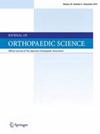Delirium following total hip or knee arthroplasty: A retrospective, single-center study
IF 1.4
4区 医学
Q3 ORTHOPEDICS
引用次数: 0
Abstract
Background
Delirium is a postoperative complication that may occur in older patients. This study aimed to investigate the incidence of postoperative delirium and its risk factors in patients who had undergone total hip arthroplasty (THA) or total knee arthroplasty (TKA). Few reports have addressed the occurrence of delirium when different methods of pain control are used following total joint arthroplasty, and, therefore, whether its incidence varied depending on differences in pain control was investigated.
Methods
The study included 500 patients (250 cases of THA and 250 of TKA). They were divided into two groups according to the occurrence of postoperative delirium, and risk factors for delirium (patient factors and operative factors) were investigated. As pain control, all patients were given a Ranawat cocktail injection, with the concomitant use of one of epidural anesthesia, nerve block, or intravenous patient-controlled analgesia (IVPCA), and the occurrence of delirium in patients using each method was investigated.
Results
On univariate analysis, advanced age, low serum albumin, nonbenzodiazepine use, and anti-parkinsonian drug use were identified as patient factors, and low postoperative minimum hemoglobin, non-use of epidural anesthesia, and non-use of nerve block were identified as operative factors associated with a significantly higher incidence of delirium. A receiver-operating characteristic curve was created for age and delirium, and the cutoff age was 77 years. On binomial logistic regression analysis for age ≥77 years, epidural anesthesia, IVPCA, and nerve block, the only factor associated with the occurrence of delirium was age, irrespective of the type of pain relief used, and the odds ratio for the occurrence of delirium at age ≥77 years was 4.64.
Conclusions
To prevent delirium following total joint arthroplasty, it is important to improve anemia and nutritional status, check and manage regular medications, and provide appropriate pain control while avoiding opioid use.
全髋关节或膝关节置换术后谵妄:一项回顾性单中心研究。
背景:谵妄是老年患者术后常见的并发症。本研究旨在探讨全髋关节置换术(THA)或全膝关节置换术(TKA)患者术后谵妄的发生率及其危险因素。很少有报道提到在全关节置换术后使用不同的疼痛控制方法时谵妄的发生,因此,其发生率是否取决于疼痛控制的差异进行了调查。方法:纳入500例患者,其中全髋关节置换术250例,全髋关节置换术250例。根据术后谵妄的发生情况分为两组,观察谵妄的危险因素(患者因素和手术因素)。作为疼痛控制,所有患者均给予拉那瓦鸡尾酒注射液,同时使用硬膜外麻醉、神经阻滞或静脉患者自控镇痛(IVPCA)中的一种,并观察每种方法下患者谵妄的发生情况。结果:在单因素分析中,高龄、低血清白蛋白、非苯二氮卓类药物的使用和抗帕金森药物的使用被确定为患者因素,术后最低血红蛋白低、未使用硬膜外麻醉和未使用神经阻滞被确定为与谵妄发生率显著升高相关的手术因素。建立了年龄和谵妄的接受者工作特征曲线,截止年龄为77岁。在年龄≥77岁、硬膜外麻醉、IVPCA和神经阻滞的二项logistic回归分析中,与谵妄发生相关的唯一因素是年龄,与使用的镇痛类型无关,≥77岁发生谵妄的优势比为4.64。结论:为了预防全关节置换术后谵妄,改善贫血和营养状况,检查和管理常规药物,适当控制疼痛,同时避免使用阿片类药物。
本文章由计算机程序翻译,如有差异,请以英文原文为准。
求助全文
约1分钟内获得全文
求助全文
来源期刊

Journal of Orthopaedic Science
医学-整形外科
CiteScore
3.00
自引率
0.00%
发文量
290
审稿时长
90 days
期刊介绍:
The Journal of Orthopaedic Science is the official peer-reviewed journal of the Japanese Orthopaedic Association. The journal publishes the latest researches and topical debates in all fields of clinical and experimental orthopaedics, including musculoskeletal medicine, sports medicine, locomotive syndrome, trauma, paediatrics, oncology and biomaterials, as well as basic researches.
 求助内容:
求助内容: 应助结果提醒方式:
应助结果提醒方式:


